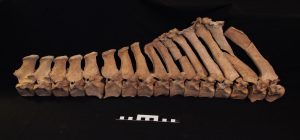The horse’s body was not meant to carry a saddle, let alone a rider encased in clanking metal.
Riding is unnatural, and although there are ways to keep the damage to a minimum, it will take a visible toll on the horse’s skeleton.
These pathologies — deviations from the normal structure of bones and teeth caused by disease, age, or stress — are a valuable tool for the zooarchaeologist as they can illuminate aspects of the animal’s life and sometimes death.
For the Warhorse Project, pathology is a true treasure trove. Injuries, possibly sustained in battle or on the tournament field, or evidence for regular riding, all hold the potential to tell us something about the lives of horses in the Middle Ages.
Bony changes in the horse’s spine are a relatively common result of riding. Fusion of several vertebrae or even entire backs can frequently be seen in the zooarchaeological record.

Abnormal bone growth caused by ‘Kissing Spine’ in a medieval horse from Latvia (Photo: H. Benkert)
The abnormal weight of a rider (or any heavy load) on their back forces the spine to bend downwards, which brings the spinous processes of the vertebrae (long bony projections protruding from the top of the vertebrae) much closer together than they should be. When they touch and grind against each other repeatedly this causes new bone growth around the affected area — a painful condition called ‘Kissing Spine’.

Fusion of vertebral bodies in a horse spine from early Anglo-Saxon Britain (Photo: H. Benkert)
To counter this, the horse will become stiff in the back in an attempt to minimise movement between the vertebrae. Similarly, the bones themselves will react to the repeated strain by growing bony bridges between vertebrae, locking them into place. Such fusion in the spine can be a normal consequence of old age and it is not uncommon to find it in two or three lumbar vertebrae. However, exceptional strain on a horse’s back may eventually lead to the complete fusion of the spine, known as a ‘bamboo spine’.
For any pathological condition to grow as severe as an immobile spine, the animal must have survived it for a considerable amount of time. That means its owners or caretakers cared for the animal, indicating a bond between humans and horses that reached beyond mere exploitation. It paints the horse as a companion and partner that did not lose its value even when it outlived its usefulness.